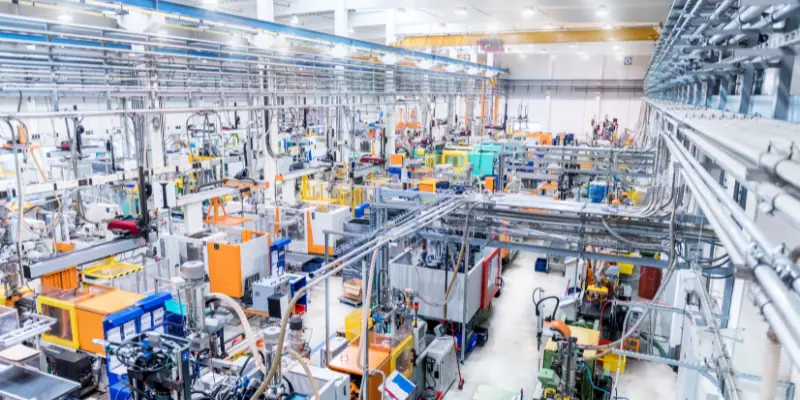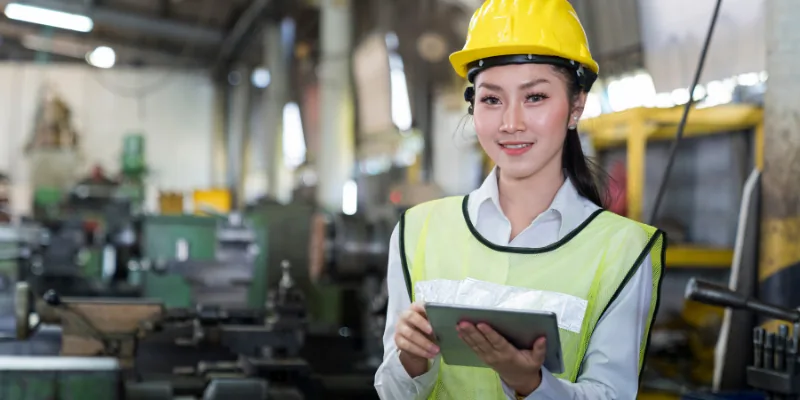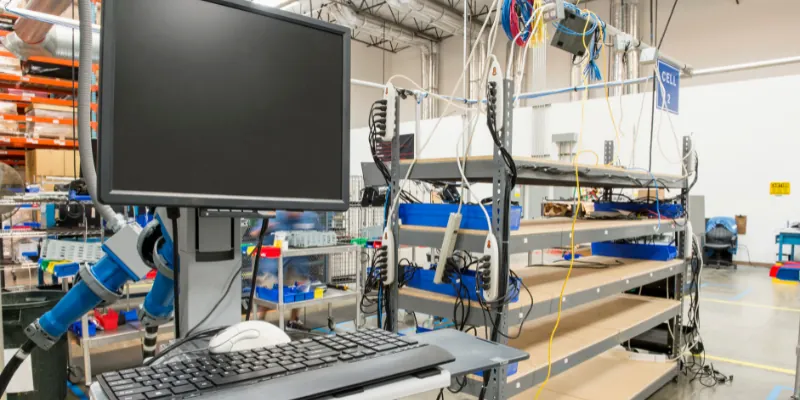Advantages of Computer in Manufacturing for Best Growth
Published: 17 Feb 2025
Computers have transformed the manufacturing industry, making production faster, more precise, and cost-effective. Studies show that automation can increase production efficiency by up to 30% while reducing errors. From robotic arms assembling cars to AI-powered quality control systems, computers play a crucial role in ensuring smooth and accurate manufacturing processes. But what makes them so essential? Let’s explore the key advantages of computer in manufacturing and how they are shaping the future of industries.
Efficiency and Speed
Computers help machines work much faster than humans, increasing production speed. Automated systems can run continuously without breaks, making manufacturing more efficient. Tasks that used to take hours or days can now be completed in minutes, reducing delays and increasing output.
- Machines can operate 24/7 without stopping.
- Automation eliminates slow manual processes.
- Production lines move faster with computerized controls.
- Computers reduce human errors that cause delays.
- Smart systems adjust speed based on demand.
- Factories meet deadlines more easily.
- Orders are processed faster and more accurately.
- Downtime is reduced because machines don’t get tired.
- Companies can produce more products in less time.
- Faster production helps businesses grow and expand.

Precision and Accuracy
Computers ensure that machines follow exact instructions, producing high-quality products. Unlike humans, computers do not make mistakes due to fatigue or distraction. This leads to precise and consistent results in every production batch.
- Products are made with exact measurements.
- Machines follow detailed digital instructions.
- Computers eliminate guesswork and human error.
- CNC machines cut materials with extreme accuracy.
- Every product is identical and meets quality standards.
- Less material is wasted due to mistakes.
- Precision ensures that parts fit together perfectly.
- High accuracy improves product durability and reliability.
- Industries like aerospace and electronics rely on precision.
- Customers receive high-quality, defect-free products.
Lower Costs
Computers help businesses save money by reducing labor costs, waste, and errors. Automation allows fewer workers to manage large-scale production, making manufacturing more cost-effective. Over time, companies recover their investment in technology through increased efficiency and lower expenses.
- Fewer workers are needed for manual tasks.
- Machines produce more in less time, reducing costs.
- Waste is minimized because of precise cutting and assembly.
- Fewer defective products lower replacement and refund costs.
- Energy-efficient machines save electricity costs.
- Digital processes reduce paperwork and administrative costs.
- Inventory management prevents overstocking or shortages.
- Maintenance costs are lower with smart monitoring systems.
- Long-term savings make automation a smart investment.
- Cost reduction helps businesses stay competitive.

Quality Control
Computers help factories maintain high product quality by detecting defects early. Automated inspection systems use cameras, sensors, and AI to find errors before products leave the production line. This ensures that customers receive reliable and high-standard goods.
- Machines inspect products more accurately than humans.
- AI detects tiny defects that are hard to see.
- Faulty products are removed before shipping.
- Quality standards are consistent across all products.
- Reduced defects mean fewer customer complaints.
- Sensors monitor production in real-time.
- Errors are fixed immediately, preventing mass defects.
- Automated systems ensure safety in sensitive industries.
- Companies build trust with customers through quality products.
- Better quality control reduces waste and saves money.
Worker Safety
Computers reduce workplace injuries by handling dangerous tasks. Machines and robots take over hazardous jobs, allowing human workers to stay safe. This makes factories safer and reduces the risk of accidents.
- Robots handle dangerous tasks like welding and cutting.
- Workers don’t need to lift heavy objects manually.
- Fewer accidents lead to lower medical costs.
- Machines can work in extreme temperatures or toxic environments.
- Sensors detect safety hazards before accidents happen.
- Employees focus on supervising instead of risky tasks.
- Safety training is improved with computer simulations.
- Workplaces follow strict safety regulations.
- Protective barriers and alarms improve safety.
- Fewer injuries mean higher worker satisfaction.

Faster Production
Computers help factories produce more products quickly and increase production when demand rises. Manufacturers can adjust machines easily to meet customer needs without major changes to their setup. This flexibility allows businesses to scale up efficiently.
- Production can be increased without hiring more workers.
- Machines can switch between different products quickly.
- Businesses meet seasonal demand easily.
- More orders can be fulfilled in less time.
- Automation prevents slowdowns and bottlenecks.
- Scaling production is easier with computerized controls.
- More products mean higher profits.
- Customization is possible without slowing production.
- Factories can expand without major infrastructure changes.
- Businesses can compete with larger manufacturers.

Inventory Management
Computers track inventory in real-time, preventing shortages and overstocking. Smart software predicts demand, helping businesses manage their stock efficiently. This ensures smooth production and prevents delays.
- Inventory levels are updated automatically.
- Shortages and excess stock are avoided.
- Raw materials are ordered at the right time.
- Storage space is used efficiently.
- Deliveries are scheduled accurately.
- Supply chains become more reliable.
- Businesses reduce waste from expired materials.
- Customer orders are processed faster.
- Stock tracking prevents lost or misplaced items.
- Better inventory management improves cash flow.
Less Waste
Computers help manufacturers use raw materials more efficiently, reducing waste and saving costs. Precision cutting and automated production minimize leftover materials, making manufacturing more sustainable.
- Machines cut materials accurately, reducing scraps.
- Waste is analyzed and minimized.
- Fewer defective products mean less material is thrown away.
- AI suggests ways to use materials more efficiently.
- Recycling processes are optimized.
- Environmental impact is reduced.
- Businesses save money on raw materials.
- Factories meet eco-friendly regulations.
- Energy-efficient machines lower resource consumption.
- Waste reduction improves sustainability efforts.
Data Analysis
Computers collect real-time data from production lines, helping businesses improve efficiency. Smart software analyzes this data to find ways to make processes faster and more cost-effective. This leads to better decision-making and continuous improvement.
- Machines provide real-time performance data.
- AI identifies production bottlenecks.
- Data helps managers improve efficiency.
- Production trends are analyzed for better planning.
- Energy and material usage are optimized.
- Reports show where cost savings are possible.
- Maintenance schedules are planned based on machine data.
- Quick problem detection prevents major breakdowns.
- Businesses make smarter investment decisions.
- Data-driven insights boost productivity.

Remote Monitoring
With smart technology, manufacturers can monitor and control machines from anywhere. Remote access allows factory managers to adjust settings, fix issues, and track performance without being on-site. This improves efficiency and reduces downtime.
- Machines can be controlled from mobile devices.
- Production is monitored 24/7.
- Problems are fixed without stopping production.
- Fewer workers are needed on-site.
- Downtime is reduced with real-time alerts.
- Factory operations are more flexible.
- Remote updates improve software without delays.
- Workers can oversee multiple locations at once.
- Security features protect against cyber threats.
- Businesses save time and money with remote access.
Computers automate repetitive tasks, reducing the need for manual labor. They help machines work faster and more accurately, speeding up production. This leads to increased output with fewer errors.
Yes! Computers minimize waste by improving accuracy and reducing errors. Automation also lowers labor costs by handling tasks that would require more workers.
Computers use sensors and AI to detect defects in products. This helps manufacturers catch issues early and prevent faulty products from reaching customers. As a result, quality improves, and waste is reduced.
While automation reduces manual tasks, humans are still needed to manage, program, and maintain machines. Many jobs are shifting toward supervising and troubleshooting technology. Instead of replacing workers, computers help them work more efficiently.
Almost every manufacturing industry benefits, including automotive, electronics, food production, and textiles. Computers help improve precision, speed, and quality in all these fields. Even small businesses use computers for design, inventory, and automation.
The biggest challenge is the high initial investment required for automation. Factories also need skilled workers to operate and maintain the technology. However, over time, the benefits outweigh the costs by improving efficiency and reducing waste.
Computers control robotic machines that handle dangerous tasks like welding or lifting heavy objects. This reduces the risk of injuries in factories. Workers can focus on monitoring and supervising rather than doing hazardous tasks.
CNC (Computer Numerical Control) is a system that controls machines like drills and cutters using computer programs. It ensures precision, making parts exactly as designed. This reduces errors and speeds up production.
The future will see more AI, IoT (Internet of Things), and smart factories where machines communicate with each other. This will further increase automation, reduce costs, and improve efficiency. Manufacturers who adopt these technologies will stay ahead in the competition.
Yes! Even small businesses can benefit from computers for inventory management, design, and automation. Using technology helps them compete with larger companies by improving efficiency and reducing costs.
Conclusion:
So guys, in this article, we’ve covered the advantages of computers in manufacturing in detail. We’ve seen how technology is shaping production lines and driving efficiency. If you’re still relying on traditional methods, I recommend taking a closer look at how computers and automation can streamline your operations. The sooner you adapt, the quicker you’ll see improvements in cost, quality, and productivity. Ready to upgrade your manufacturing process? Take the first step today!

- Be Respectful
- Stay Relevant
- Stay Positive
- True Feedback
- Encourage Discussion
- Avoid Spamming
- No Fake News
- Don't Copy-Paste
- No Personal Attacks

- Be Respectful
- Stay Relevant
- Stay Positive
- True Feedback
- Encourage Discussion
- Avoid Spamming
- No Fake News
- Don't Copy-Paste
- No Personal Attacks
